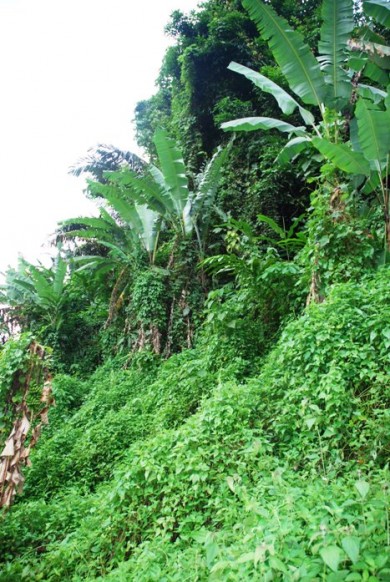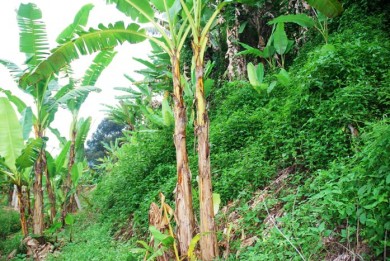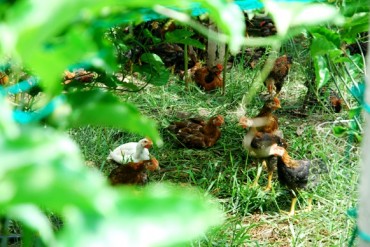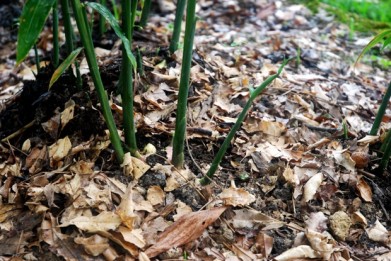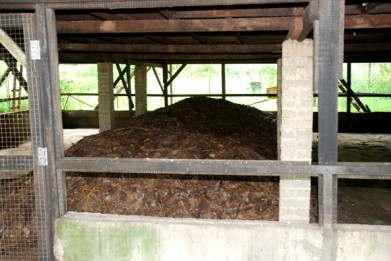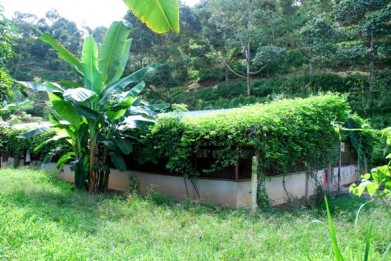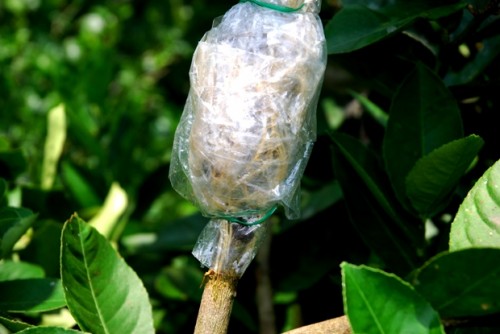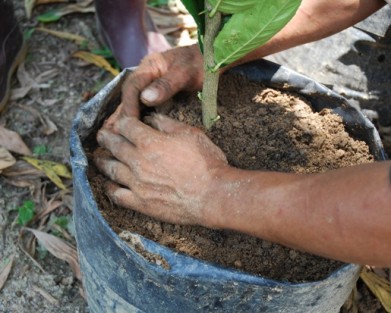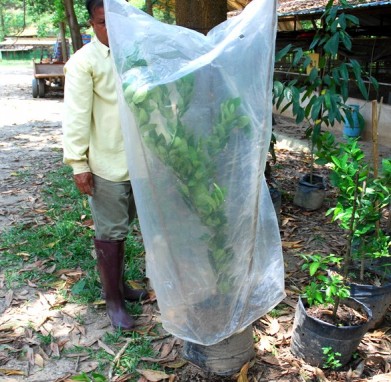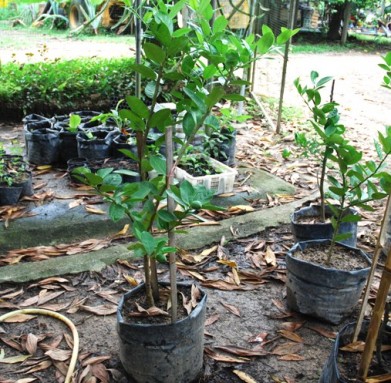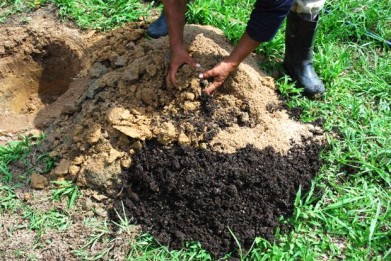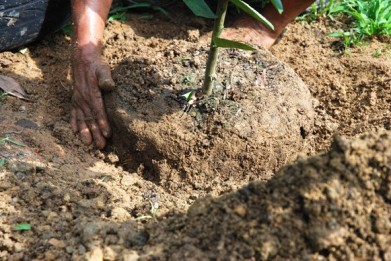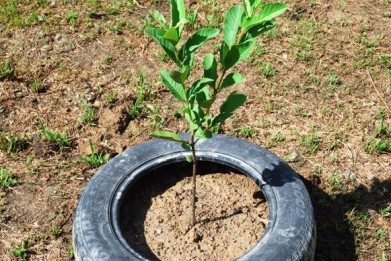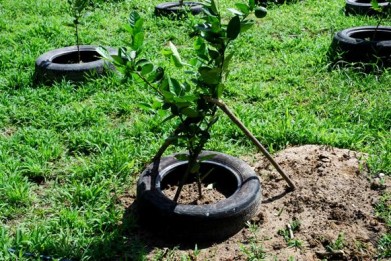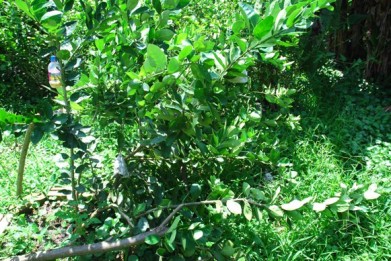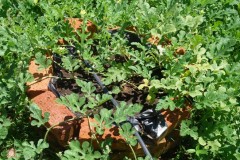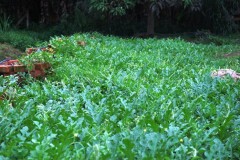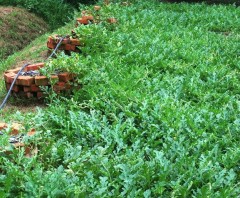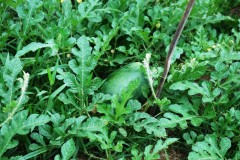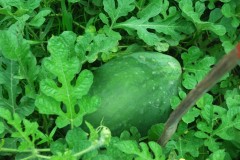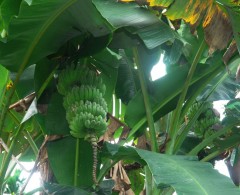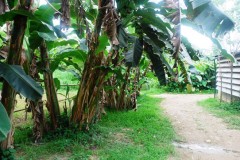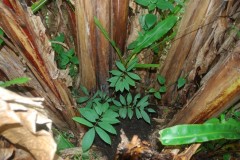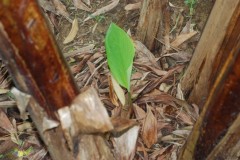Apr 15, 2013
Sights And Sounds Of The Farm - Emerald Doves
Emerald Doves are usually very flighty and nervous near humans due to poaching. At our farm, they are resident and are found in many nooks and corners. Many times they will just swagger off, in a pigeony way (which they are) when they see us. Here's one that's just in front of our workers' quarters. The video of it feeding in our garden captures the sounds of the farm at around 11 am, mid-morning. If we hadn't tell you, you would think the video is in the forest with the myriad sounds of birds and insects. But that's what we are trying to achieve in our farming - that we can be commercial and yet be in harmony with Nature.
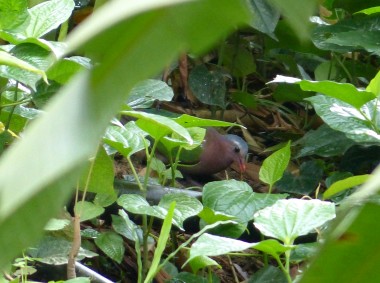
Here's a recording of the sounds that you will hear at our farm. You would be forgiven if you think you are in the jungle.
16:12 Posted in Blog, Permaculture, Sustainable Farming | Permalink | Comments (0) | Tags: emerald dove, nature farming, permaculture, sounds of tropical forest, punai tanah
Aug 04, 2012
Mimicking Nature - Can We?
The forest have many layers.
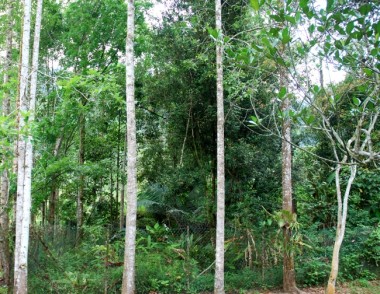
Permaculturists say 7 0r 8. I think more. Under the soil, many more layers to be discovered. I planted a small 50ft x 60 ft layer garden. A meranti tree is the canopy tree. Then eugenias and so on. In no time, a multitude of life forms made the garden their home. Lichens that I have never seen. Fungi, frogs, birds, insects, and unseen, millions maybe billions of microbial life that infuse the garden with energy or qi.
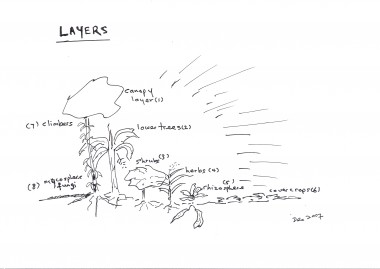
Can this multi-layered model of sustainability, successful for 150 million years, be applied to our modern food needs?
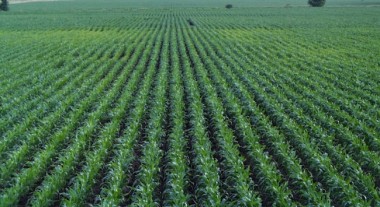
The modern farm - a barren blight on the earth. Can we grow food and yet support a multitude of life forms and working with these lifeforms reduce chemical and energy inputs? Perhaps we should start with reexamining what is meant by 'productivity'.
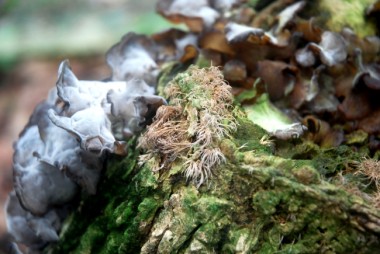
Life forms most of us have never seem have appeared in my little layered garden.
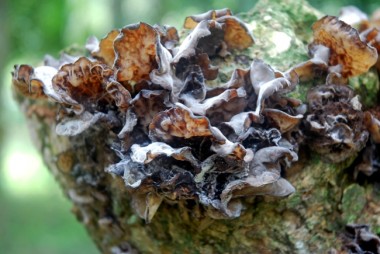
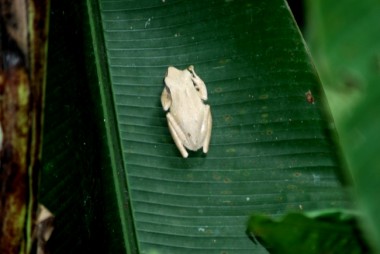
I have never seen this frog in a farm. Have you?
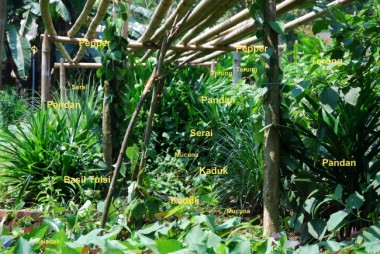
This is the start of a layered food model. Can we extend this to a commercial scale and yet remain efficient in terms of labour, harvesting, cycling, inputs? What new measures do we need to work out its productivity against that of conventional mono crops?
15:16 | Permalink | Comments (0) | Tags: permaculture, layered garden, layered forest, new model for agriculture
Jul 22, 2012
Forest In A Farm
Twenty years ago, we started to plant forest trees in a zone within the farm. Today, some of the trees are 100 feet tall, and of course, still growing. We plan now to develop this zone into an area of bio-diversity and hopefully, some of the animal life driven off by logging uphill, will instead make this zone their home. The forest uphill was home to siamang, wild cats, and many more.
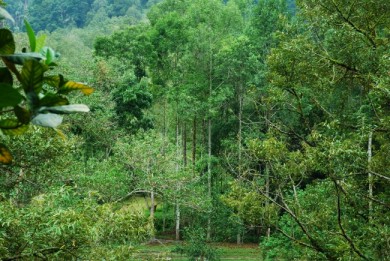
Canopy trees in a farm!
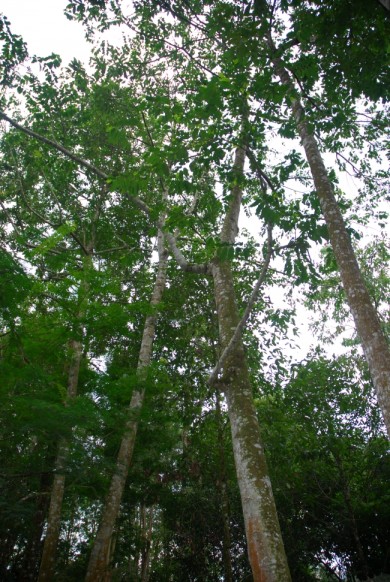
Meranti
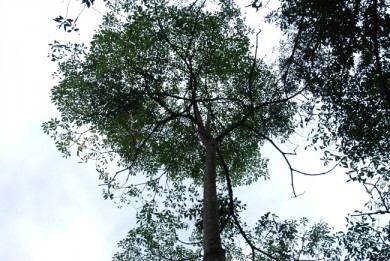
Pulai
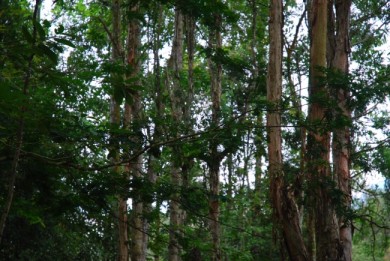
Gelam

Kasai
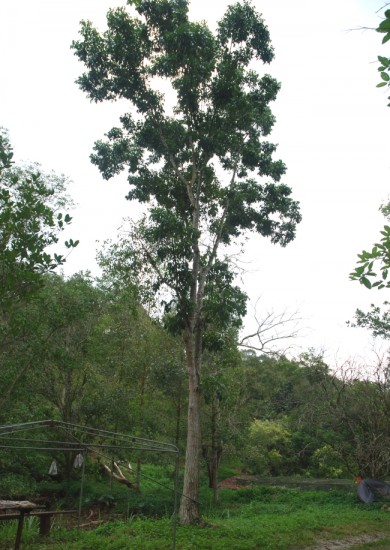
Mahagony
Sustainable agriculture is long term, planning decades ahead, not months or weeks.

At one end of the zone is this beautiful location, perhaps a suitable site for a Sustainable Agricullture Institute.
08:02 Posted in Blog, Permaculture, Sustainable Farming | Permalink | Comments (0) | Tags: agro forestry, permaculture, meranti, nyatoh, pulai, rain trees
Oct 14, 2011
Slope Farming I
Land is getting scarce and sometimes we have to work on very steep slopes.
Accessibility and erosion then become major concerns.
Using used tires to make stairways is one way to create permanent, stable access with minimal erosion.
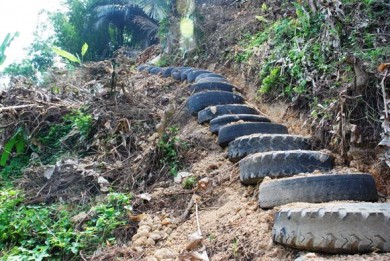
The top rim of the tire should be removed (using a full tang, heavy survival knife is best for this job). Earth used to fill the tires should then be compacted.
This stairway has been holding itself very well with no erosion or stability problems through two monsoon seasons now.
12:35 Posted in Permaculture, Sustainable Farming | Permalink | Comments (1) | Tags: uses for used tires, tire gardening, tire stairs, permaculture, sustainable agriculture
Aug 03, 2011
Free Range Chicken - Natural Sun-Shading I
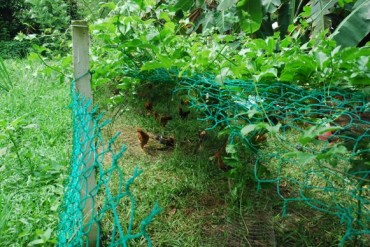
This Ramadan sure is hot. For the watermelon seller, bad sales surely is not his lot. The chickens listlessly loll. Under the markisa shelters. Aren't we glad we had tolled. These lovely markisa all to enjoy.
Yesterday was 40 celcius. Hot enough for these chickens to drop dead from heat stroke. And we are talking about ayam kampung, tough as nails!
Natural sun shading used in the farm includes these passion-fruit vines and clumps of big-leafed pisang sematu. Remember, bare earth retains and reflects heat. Bare earth patches can be 5 celcius higher than grass covered patches. And all water-lines MUST be protected from the sun.
A friend of mine is running a closed-house farm. He is cursing day-and-night over his energy bills.
Selamat berpuasa.
10:20 Posted in Chickens, Permaculture | Permalink | Comments (1) | Tags: permaculture, free range chickens, sun shading, passion fruit, markisa, ramadan
Apr 13, 2011
Permaculture At The Farm II
Here are more examples of permaculture (permanent agriculture) at the farm:
Mulching to reduce water loss. Previously we advocated sheet mulching (to reduce weeds, etc ) with cardboard and other cellulose based material. DON'T DO IT! Termites love these heavy cellulose material. Mulching in humid Malaysia should be light to avoid termites and fungal problems. Leguminous cover crop as living mulch is a better idea.
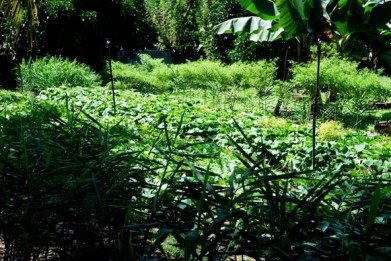
Multi-crop and companion planting of gingers, chilies, sweet potatoes, water melon and passion fruits on raised beds. Permaculture is antithetical to mono-cropping (think oil palm, or think dragon fruit farms; organic or otherwise). On a small farm level, mono-cropping often leads to increasing dependence on chemicals and crops are often decimated suddenly by disease. The recent demise of many dragon fruit farms, both conventional and organic, is one example.
Serai or lemon grass on raised beds with sweet potato as living mulch and companion. Once the sweet potatoes are harvested, leguminous cover crop will be planted to revitalise the soil.
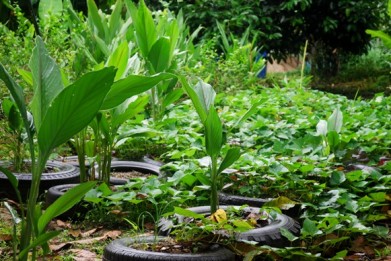
A low maintenance food garden grown entirely on used tires on low yield soggy, clayey soil. Practically no weeding is needed and monthly dressing of compost is all that's needed to produce sweet potatoes, curcuma mangga, lempoyang, kunyit and common ginger.
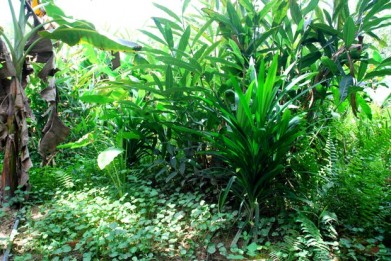
A 3000 sq ft food forest with very low maintenance, fed by a grey water treatment pond, producing taro, banana, papaya, pegaga, lengkuas, pandan, misai kucing, geranggau and other herbs. It provides a rich habitat for wild birds, eels, haruan, sepat, frogs, butterflies, insects, snakes, etc. It is one of our favorite spots in the farm. However, not everybody likes the overly 'friendly' snakes ( we counted 7 species so far ).
Under the traditional Asian chicken coop (on stilts), in-situ composting ( with the aid of farm-brewed IMOs ). This reduces human energy ( in having to remove the dung after every cycle). Removal of the composted material is done once every 8 months or so, and goes straight to the durian trees.
More examples of sun shading using plants - passionfruit, banana ( sematu, as it can reach 20 feet or more, high) and gliricidia septum.

Integrating animal husbandry with fruits - here, free range chickens with bananas. There is no necessity to fertilise the fruit trees at all. Do not integrate durians with chickens.
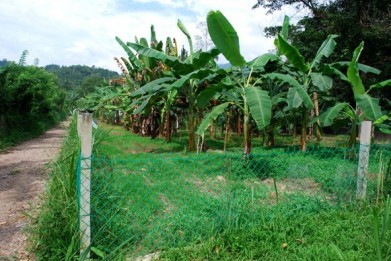
Sematu is best - it has large leaves providing good shade, grows fast and is more hardy than 'improved' bananas like mas or berangan. The sematu above are young trees, barely three months old.
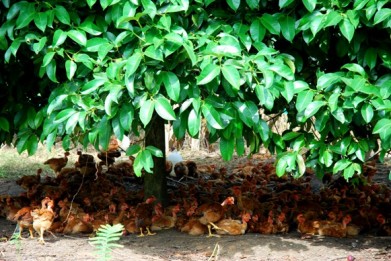
Free range chickens with mangosteen - here, hiding from the mid-day sun under the mangosteen fruit trees.
17:21 Posted in Permaculture | Permalink | Comments (2) | Tags: permaculture, free range chickens, sun shading, grey water treatment, integrated farming, permaculture examples, raised beds, companion planting, mulching, sheet mulching
Apr 08, 2011
Marcotting II
We generally have good root formation in around 30 to 45 days for lemon trees and other limau-type trees.
Saw off, and dap some iodine on the cut
Wrap vermicast around the root ball
Plant in a polybag with a light, friable and loose soil mix. We like to add some sand and vermicast to our farm soil. Loose, light soil will encourage the roots to grow deeper.
Cover the plant with a plastic bag to prevent drying out. Remove when new leaves and branch shoots are noticeable. Once the new leaves and shoots are established, plant to soil.
The area where we are planting these citruses have heavy laterite soil. We generally dig a hole and then mix the laterite with sand and compost.
We mix the laterite with sand and vermicast or compost
Place the plant half inside the hole
A planted marcotted guava
We generally place an used tire over the spot and top up the soil mix as need be. The tire reduces weeds, and prevent leachate of compost and vermicast.
Support the young tree. Marcotted trees tend to be shallow rooted and care must be taken during windy monsoon seasons.
5 year old marcotted lemon tree falling over after a night of heavy rain and strong winds. Marcotted trees have no tap root so should be supported even when matured in windy zones.
12:37 Posted in Blog | Permalink | Comments (0) | Tags: marcotting, air layering, lemon, organic farming, permaculture
Mar 14, 2011
Permaculture At The Farm I
Here's some permanent agriculture (permaculture) features at the farm:
Alley cropping of napia grasses to reduce pressure on arable land for ruminants. By cultivating grasses we can raise up to 200 goats per acre of land versus around 15 here in Malaysia. We alley crop with nitrogen-fixing leguminous gliricidia septum. It may be necessary to fallow with leguminous cover crops after a couple of years. At the moment, we ferment chicken discards such as feathers, guts, etc. to produce a liquid fertiliser, and fertilise twice a year. So far, production of grass has been maintained, a good example of sustainability.
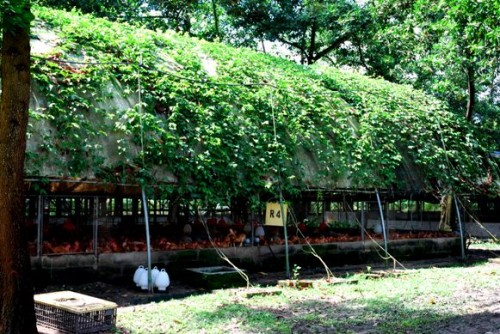
Passion (fruit) vines grow fast, and produce sufficient foliage to impart noticeable cooling. Sun-shading using plants is efficient, easy, with little maintenance needed, and have practically no running costs. Next, passiflora shades in the chicken fields; side effects - more insects and vitamin Cs for the chickens!
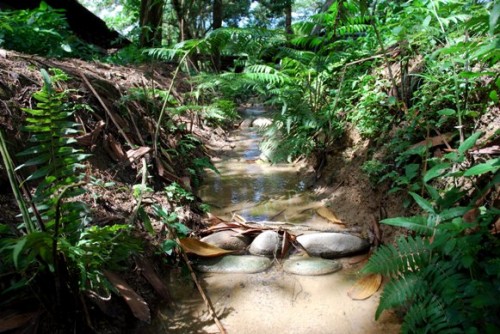
Earth drains permit infiltration of water and generally slows down run-offs. However, in our heavy monsoon downpours, earth drains need regular maintenance and may contribute to erosion.
A judicious mix of earth and concrete drains may be necessary, in addition to other water retention and diversion strategies.
Earth drains increase available planting spaces in small farms. Earth drains at our farm are income generating, producing a variety of crops - watercress, edible ferns, pandan leaves, arrowroots, and various edible taro tubers.
The picture shows the laying of low stone barriers across earth drains to slow down water flow and hence reducing erosion. They also allow for deeper, slower flowing sections enabling feeding and hence increasing the population of wild eels which are harvested.

Shaping of land to create catchment areas to retain water, to slow down flow of rain water, and in the case in this picture, to reduce water-logged areas. In the process planting spaces are created for growing water loving vegetables - here, just planted watercress and arrowroot.
After a down pour, the land used to get soggy and difficult to work for days. With these catchment areas, the soggy areas are gone and the catchment area retains water for weeks (due to high water table) - good for planting income generating water loving vegetables.
12:03 Posted in Permaculture | Permalink | Comments (2) | Tags: permaculture, napia grass, sustainable agriculture, organic farming, natural sun-shading, passion fruits, swales, earth drains, retention ponds
Apr 30, 2010
Watermelon on Raised Beds
People don't grow watermelons on raised beds. That's what they told us.
Right, and that's why, we supposed, conventionally grown local watermelon have such a bad reputation for pesticides and fungicides!
It's logical, our climate is humid and wet, not really ideal for watermelon.
Further, local weeds will overwhelm the watermelon plant in days. So if we plant them on the ground then its logical that pests, fungal diseases and weeds must be kept at bay using a cocktail of chemicals - 3 in one!! :)
This is the raised bed we used:
Four bricks high, layer of compost at the bottom and filled to the brim with sand.
If you are planning to grow on a larger scale, do not use bricks, they are not really practical. Recycle discarded tires - just stack up two.
Lush watermelon plants fed farm-made compost tea once a week.
Heavy, succulent fruits on the way.
Things will go wrong, just don't throw out the baby with the bath water.
There are many possible reasons why the watermelon plant may not do well. Try to investigate, keep records, and modify and adapt.
One of the most common reasons is wrong seed. You will be surprised how often this mistake is made. Seeds from Japan, Taiwan, etc are not suited for growing naturally in our climate though they may thrive doing so in their home countries. We need to duplicate the conditions back home but that's not a route that sustainable farming should take.
11:05 Posted in Permaculture | Permalink | Comments (0) | Tags: raised beds, key hole garden, permaculture, watermelon
Apr 26, 2010
Permaculture is Bananas
Banana plants (it's a giant herb) can make their own food, retain water, and in our farm continuously produce 20 to 40 kg bunches without significant input.
Banana plants at our farm. Producing fruits year after year in the same spot without replanting.
Nowadays farmers grow rows and rows of tissue-cultured clones. These require high fertiliser and fungicide inputs.
At our farm, the banana epitomises permanent agriculture. We use our human intelligence to plant them at the right place - they like moisture and organic material. They will form a clump - trim the clump to about 4 to 5 plants so that they will produce reasonable sized bunches
A banana clump serves as a heat absorber. They cool down the earth due to their ability to retain water and reduce radiation of heat to buildings due to their shady leaves.
The centre of the clump hosts myriad microbes and earthworms due to its dark and moist conditions rich in organic matter. They quickly break down fallen leaves, dead trunks, etc into humus and then release these nutrients back to the clump as food. We only need to occasionally supplement with some compost and some chopped dead trunks.
We plant tuba or derris elliptica in the centre. The clump provides all the nutrients that the derris require. We don't even need to water the derris.
Derris in the clump :).
We have found that gingers do well in the clumps too. Gingers love organic matter and moisture. We are now planting ginger in all the clumps in the farm as a cash crop.
This temu kunci is growing at a faster rate than others planted outside the clump.
We, humans, have a choice - clear the land, plant rows and rows of clones and hybrids, feed them with synthetic nitrogen-based fertilisers and spray them with fungicides and due to the low contribution margin for such crops, go for 'volume', ie clear up more land to generate this 'volume';
Or go the permaculture way - use nature intelligently and work with nature to produce food for us for generations. We may not be rich in the short term, but we will be around for a far longer time. Multiple this idea by 100,000 farms and the landscape of the Earth's future changes!
16:44 Posted in Permaculture | Permalink | Comments (4) | Tags: permaculture, bananas, raised beds, compost, derris elliiptica, temu kunci, boesenbergia rotunda








